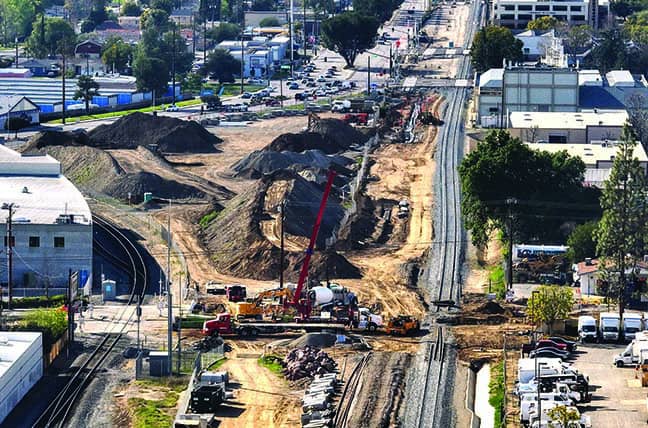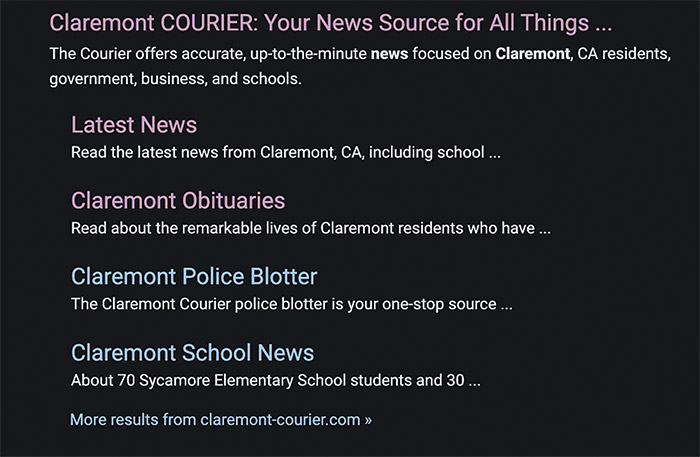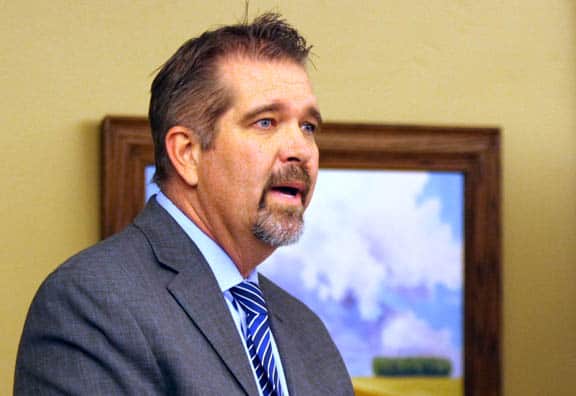Gold Line extension may get another funding lifeline

A work crew at work on the Gold Line extension project in March near the intersection of White Avenue and Arrow Highway in La Verne. COURIER photo/Peter Weinberger
by Steven Felschundneff | steven@claremont-courier.com
The light rail system formerly known as the Gold Line may seem like a mirage that remains just out of reach, but it now appears to have yet another opportunity to finally make it to Claremont.
By a unanimous vote on December 1, the Los Angeles County Metropolitan Transportation Authority Board included extending light rail service through to Montclair as one of three projects prioritized for funding under the 2023, sixth cycle Transit and Intercity Rail Capital Program.
California State Transportation Agency recently published its 2023 “final guidelines and call for projects” for existing TIRCP ventures with a submission deadline of Tuesday, December 6. The state agency also requested that Metro submit multiple project applications and prioritize each one in its request for funding. Factors the state agency will consider include projects that have previously received TIRCP money, are construction ready, provide public transportation opportunities to disadvantaged communities, maintain or leverage a local or federal funding sources and meet a June 2027 deadline to expend the funds.
In Metro’s application, the Gold Line extension, now called the L Line, from Pomona to Montclair, was ranked second of three projects with $798 million requested from the state. A light rail project in east San Fernando Valley was the top priority and a transit corridor through west Santa Ana was third.

A work crew at work on the Gold Line extension project in March near the intersection of White Avenue and Arrow Highway in La Verne. COURIER photo/Peter Weinberger
“This [L Line] project is (a) construction ready, (b) environmentally cleared, and (c) at risk of losing access to $39 million in committed local San Bernardino County funds if CalSTA does not award supplemental state funding to the project,” according to a staff report prepared for the Metro board. “This project also serves Equity Focused Communities (4% identified as Very High Need or High Need) within the corridor, although not as extensively as the [East San Fernando Valley] Project.”
Metro is proposing a three-year funding program to the state which would require that additional money be allocated from future budgets. It will be up to the state grant administrators to decide how much money — if any — will be granted to each project submitted, and it will be up to the state to decide if it will accept the multi-year requests, according to the Gold Line Extension Authority’s Chief Communications and Strategic Development Officer Lisa Levy Buch.
“For us the good news is we were identified as one of three programs to be funded,” Buch said.
Assembly bill 180 amended California’s budget for the fiscal year 2021, adding a one-time allotment of $3.63 billion to be spent on transportation infrastructure statewide. About half of that money, $1.83 billion, will fund projects in Southern California. If the state approves Metro’s two top priorities — $600 million for the San Fernando Valley project and $798 million for the L Line — they would constitute about 75% of the total allocation for the region. However, Los Angeles County’s proposals have to compete with projects from Imperial, Orange, Riverside, San Bernardino, San Diego, and Ventura counties.
“Of the Southern California subtotal, AB 180 requires that no less than $900 million be set-aside for ‘Existing TIRCP Projects Leveraging Federal & Local Funds Reserve’ (‘Existing TIRCP Projects’) that have previously received TIRCP grants and can demonstrate that a supplemental state grant would ‘leverage’ or ‘maintain’ an identified source of significant local or federal investment,” according to the staff report.
The Gold Line Extension Authority received $290 million in TIRCP grants in 2018.
There may be an avenue for additional funding because Senate bill 198 signals the legislature’s intent to allocate an additional $4 billion over the next two fiscal years. Plus, the state uses a population-based formula that could benefit Los Angeles County because approximately 25% of California’s residents live here.
“Through AB 180 and SB 198 formula funds, staff believes that the maximum capacity available to Metro through this grant opportunity could reach [$2.68 billion],” according to the staff report.
“If Metro receives maximum capacity available, it assumes Metro is awarded [$1.68 billion] of the [$1.83 billion] available in Cycle 6 or 91.7% of available funds for Southern California. The remaining [$1 billion] will come from SB198 in future years,” Buch said.
Metro expects to find out whether its funding requests have been granted by the end of January.
“Last week’s action by the Metro board is an important first step toward securing the funding needed to complete the Foothill Gold Line to Claremont and Montclair,” said Habib F. Balian, CEO, of Foothill Gold Line Construction Authority. “Together, Metro and the Construction Authority will apply for state grant funding. We believe that the Foothill Gold Line is in an excellent position to compete well against other projects in Southern California, as part of the L.A. County request. The project is construction-ready and can be completed within the necessary timeframe, and therefore can start creating jobs and economic benefits for our region and the state.”
The 12.3-mile Gold Line (now L Line) extension was originally scheduled to connect the line’s current terminus in Azusa through Glendora, San Dimas, La Verne, Pomona, and Claremont, ending in Montclair. In 2018, when construction bids came in hundreds of millions of dollars above the amount of funding secured, the decision was made to end the line at Pomona North, which is near the intersection of Bonita and Garey avenues.
In August 2019, the construction authority awarded an $805.6 million contract to Kiewit-Parsons for the first nine miles of the extension, with a two-year option to complete the full 12.3 miles. However, funding from the state was not secured by the October 2021 deadline, and the option to complete the project for $540 million expired.
Completing the final roughly 3.5-mile segment is expected to generate 7,700 weekday boardings, more than half of the six-station extensions’ total ridership, according to a March letter from the City of Claremont requesting that the project be funded. Trips from these two stations are projected to replace 26.7 million vehicle miles traveled annually, eliminating millions of tons of carbon dioxide emitted into the local atmosphere.
“We want to thank our legislators, local elected officials and community members who took the time to write letters and speak in support of the project to the Metro board, as well as the Metro board for their continued commitment to see the project completed,” Balian said.
The Foothill Gold Line announced December 1 the light rail line to Pomona is 62% complete and it was wrapping up construction work that had caused traffic delays at the intersection of Foothill Boulevard and Grand Avenue in Glendora.









0 Comments